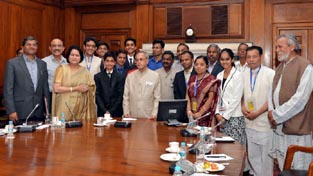
NEW DELHI, Mar 19:
Artists and writers who are part of the ongoing ‘In-Residence’ programme at the Rashtrapati Bhavan are retelling the estate’s legacy in their photographs, paintings and compositions, producing some awe-inspiring results.
Rajesh P Kargutkar (31), a Mumbai–based multi-disciplinary artist has conjured up typography portraits of India’s all 13 Presidents by using a single word that, he says, describes best each one of them.
Haobam Sanaton Singh (55), a portrait artist from Manipur, has captured the peculiarities and colours of the estate’s legacy and culture in his creations.
Kargutkar and Sanaton, along with Odiya writer and Sahitya Akademi Yuva Puruskar 2011 winner Gayatribala Panda and Bangalore-born non-fiction writer Vikram Sampath, form the current batch of artists of the programme.
For two portraits of President Pranab Mukherjee, Kargutkar has used the words ‘teacher’ and ‘culture’. For former president A P J Abdul Kalam, he has used the word ‘missile man’, acknowledging his contribution to missile programme of the country, ‘freedom fighter’ for first president Rajendra Prasad, ‘social woman’ for first woman president Pratibha Patil and ‘fundamentalist’ for K R Narayanan.
“I see him as a teacher (Mukherjee) and that’s what he was before joining politics. I not only see him as our president but there is more to him,” he says.
Kargutkar is fascinated by the tension between reality and representation and in his experimental work with video and photography and he focuses more on “the chaos” in the way of living.
The last time when he visited Delhi some years ago, he could only see the Rashtrapati Bhavan from India Gate and was “mesmerised by its sheer beauty”.
“I could see the building from India Gate. This is so simple, one mammoth structure and a clear blue sky behind it.
“Now, I am here and it is a privilege, I see there is so much to do visually here. There are so many themes and topics you can work on,” he says.
Singh (55) paints portraits and have so far done over 210 of them, including of Olympic Bronze medallist boxer M C Mary Kom. He owns an art gallery in Imphal and the entry to it is free. His paintings are not for sale, he says.
“I do not appreciate people asking me the price of my paintings. They are not for sale. I tell them that the paintings will stay in the gallery for their grand children and great grand children to see,” Singh says.
Singh, during his stay in Rashtrapati Bhavan, drew two paintings depicting the culture in the estate. He wishes to speak to the President to help him set up an institute where he could impart “free training to those who want to learn”.
Vikram Sampath, a young historian and writer, has got a distinct taste in arts. He feeds on non-fiction and is attracted towards the rich history of the country.
Vikram, who has penned three books and won the Sahitya Akademi Yuva Puraskar 2012 for ‘Splendours of Royal Mysore’, an extensive 760-page account on the Wodeyar royals of the erstwhile princely state of Mysore, has also played a key role in setting up the first archive of Indian music in Bangalore which seeks to digitise and preserve valuable extracts from India’s cultural history and musical heritage.
Vikram in his research trip Germany discovered that a Berlin gallery had in store the recorded voices of Indian prisoners of World War II on gramophone shellacs and wondered “why we India didn’t have such a facility?” (PTI)

